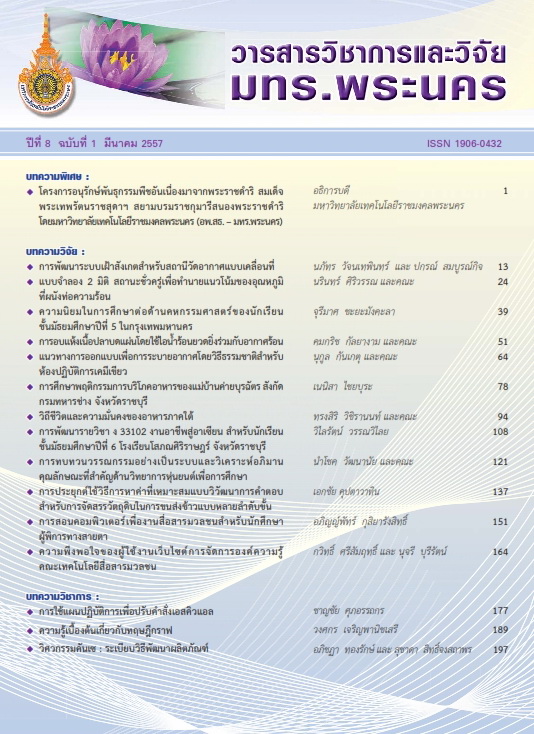แนวทางการออกแบบเพื่อการระบายอากาศโดยวิธีธรรมชาติสำหรับห้องปฏิบัติการเคมีเขียว
Main Article Content
Abstract
บทคัดย่อ
การศึกษานี้มุ่งเน้นการออกแบบรูปแบบช่องเปิดสำหรับการระบายอากาศโดยวิธีธรรมชาติที่เหมาะสมสำหรับห้องปฏิบัติการเคมีเขียวให้สอดคล้องกับสภาพอากาศของประเทศไทย ซึ่งปัจจุบันยังไม่มีแนวทางการออกแบบ เพื่อส่งเสริมการระบายอากาศโดยวิธีธรรมชาติสำหรับห้องปฏิบัติการเคมีในประเทศ และยังเป็นทางเลือกในการช่วยประหยัดพลังงานเครื่องปรับอากาศอีกทางหนึ่งโดยใช้โปรแกรมการคำนวณอุณหพลศาสตร์ของไหล (Computational fluid dynamics: CFD) เพื่อจำลองหารูปแบบทิศทางการวางผังอาคารและรูปแบบของช่องเปิดสำหรับการระบายอากาศโดยวิธีธรรมชาติที่เหมาะสมตามรูปแบบมาตรฐานห้องปฏิบัติการเคมี จากนั้นทำการจำลองแนวทางการออกแบบวางผังและการจัดตำแหน่งช่องเปิด อาคารประเภทแบบทางเดินเดี่ยว (single-loaded corridor) แบบทางเดินร่วม (double-loaded corridor) และแบบทางเดินรอบแกนบริการ (atrium-loaded corridor) โดยทดลองเปรียบเทียบทิศทางลม 8 ทิศทาง และกำหนดอัตราความเร็วลมตั้งต้น เท่ากับ 2 เมตรต่อวินาที ผลการศึกษาสรุปว่า แนวทางการจัดผังและการวางช่องเปิดอาคารประเภทแบบทางเดินเดี่ยว (single-loaded corridor) ในทิศทางที่ลมทำมุมกับอาคาร 180 องศา และมีอัตราความเร็วลมเฉลี่ยในพื้นที่ห้องปฏิบัติการมากกว่า 0.5 เมตรต่อวินาที ทำให้เกิดภาวะน่าสบายที่เหมาะสม สำหรับการระบายอากาศโดยวิธีธรรมชาติในห้องปฏิบัติการเคมี เป็นการช่วยลดการใช้พลังงานส่งเสริมคุณภาพสภาพแวดล้อมภายในและตอบสนองความต้องการของผู้ใช้ สอดคล้องกับรูปแบบมาตรฐานและหลักการออกแบบห้องปฏิบัติการเคมีเขียว
Abstract
This study focuses on appropriate opening design of natural ventilation for green chemistry laboratories in Thailand. Even though natural ventilation is an alternative way to save energy from using air conditionings, nowadays, there is no design guideline to promote natural ventilation for chemistry laboratories in the country. Computational fluid dynamics (CFD) was used to simulate building models with various orientations and opening types. Then, a set of simulations was run to test the effect of lay-out designs and opening locations, in conjunction with the type of building models, such as single-loaded corridor, double-loaded corridor and atrium-loaded corridor, by comparing ventilation performance with 8 wind directions at the speed of 2 meters per second. Results show that the single-loaded corridor lay-out design and opening arrangement which angled at 180 degree of wind direction and average wind speed of more than 0.5 meter per second was the most suitable comfort for improved natural ventilation in chemistry laboratories. Natural ventilation helps in reducing energy consumption, improving quality of indoor environment and responding to the need of users, based on standards and principles of green chemistry laboratory design.


